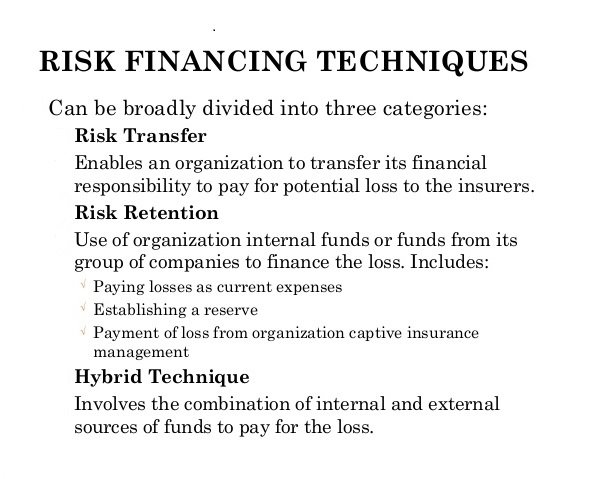Risk financing is the determination of how an organization will pay for loss events in the most effective and least costly way possible. Risk financing involves the identification of risks, determining how to finance the risk, and monitoring the effectiveness of the financing technique that is chosen.
Risk financing is designed to help a business align its desire to take on new risks to grow, with its ability to pay for those risks. Businesses must weigh the potential costs of their actions and whether the action will help the business reach its objectives. The business will examine its priorities to determine whether it is taking on the appropriate amount of risk to achieve its objectives. It’ll also examine whether it is taking the right types of risks and whether the costs of these risks are being accounted for financially.
Companies have a variety of options when it comes to protecting themselves from risk. Commercial insurance policies, captive insurance, self-insurance, and other alternative risk transfer schemes are available, though the effectiveness of each depends on the size of the organization, the organization’s financial situation, the risks that the organization faces and the organization’s overall objectives. Risk financing seeks to choose the option that is the least costly, but it also must ensure the organization has the financial resources available to continue its objectives after a loss event occurs.
The process for determining risk financing typically involves a company forecasting the losses that they expect to experience over a period of time and then determining the net present value of the costs associated with the different risk financing alternatives available to them. Each option is likely to have different costs, depending on the risks that need coverage, the loss development index that is most applicable to the company, the cost of maintaining a staff to monitor the program and any consulting, legal, or external experts that are needed.


Risk Financing as an Indicator of Financial Health
How a company manages situations that call for risk financing is a good indicator of that organization’s competitiveness and potential for long term success. That’s because risk financing depends on the aptitude of business leaders to identify and monitor key metrics that provide insight into its financial health. One of the most widely accepted of those key metrics is Cost of Risk (COR), a quantitative measure of the total direct and indirect expenditures dedicated to mitigating the risk exposures. While typically interpreted to capture only those costs arising out of insurance activities (i.e. retained losses, risk control costs, insurance premiums, and dept administration expenses), true COR captures expenditures (risk spend) from external risk transfer, retained/self-insured losses, external consultancy fees, internal program administration, collateral costs and missed opportunity costs.